Abstract
As one of the three major chronic diseases, diabetes often causes many complications, which can affect various parts of the body and even threaten the life of the patients. At present, the situation of diabetes in the world is quite serious. Accurate detection of blood glucose is very important for the diagnosis, treatment and medication of diabetes as well as the self-management of diabetic patients. In this paper, an electrochemical glucose biosensor was developed based on screen-printed electrode (SPE) modified with composite material of graphene aerogel (GA) and Prussian blue (PB) (denoted as GA@PB), which was fabricated via chemical reduction using L-ascorbic acid as a reducing agent through a freeze-drying process. Glucose was specifically captured by glucose oxidase (GOx) which were immobilized into the GA@PB by chitosan. The structure and performance of the sensor were characterized by scanning electron microscopy (SEM), Raman spectroscopy measurements, Fourier transform infrared spectrometer (FTIR), cyclic voltammetry (CV) and amperometric detection. The sensor exhibited a linear range of 0.5–6.0 mmol·L−1 with limit of detection (LOD) of 0.15 mmol·L−1, indicating that the combination of graphene aerogel and Prussian blue possess well conductivity and catalytic performance.






Similar content being viewed by others
Abbreviations
- SPE:
-
Screen-printed electrode
- PB:
-
Prussian blue
- GA:
-
Graphene aerogel
- GOx:
-
Glucose oxidase
- CV:
-
Cyclic voltammetry
References
B. Bansod, T. Kumar, R. Thakur, S. Rana, I. Singh, Biosens. Bioelectron. 94, 443–455 (2017)
B.J. Brownlee, M. Bahari, J.N. Harb, J.C. Claussen, B.D. Iverson, Appl. Mater. Interfaces 10(34), 28351–28360 (2018)
L. Chen, X.J. Wang, X.T. Zhang, H.M. Zhang, J. Mater. Chem. 22(41), 22090–22096 (2012)
T. Dayakar, K. Venkateswara Rao, K. Bikshalu, V. Rajendar, S.H. Park, Mater. Sci. Eng. C 75, 1472–1479 (2017)
H. Ding, L. Zhao, Y. Li, X. He, Asian J. Chem. 20(3), 2327–2336 (2008)
A.M. Farah, F.T. Thema, E.D. Dikio, Int. J. Electrochem. Sci. 7(6), 5069–5083 (2012)
M.P. Gangola, S. Jaiswal, Y.P. Khedikar, R.N. Chibbar, Food Chem. 154, 127–133 (2014)
K. Grennan, A.J. Killard, M.R. Smyth, Electroanalysis 13(8–9), 745–750 (2001)
T. Hu, Y. Ye, K. Chen, F.F. Long, W. Sang, Y.L. Zhou, D.K. Sun, Z.H. Ni, Anal. Methods 10(48), 5749–5754 (2018)
M. Inagaki, F.Y. Kang, J. Mater. Chem. A 2(33), 13193–13206 (2014)
A.A. Karyakin, E.E. Karyakina, Russ. Chem. Bull. 50(10), 1811–1817 (2001)
Z.F. Li, J.H. Chen, W. Li, K. Chen, L.H. Nie, S.Z. Yao, J. Electroanal. Chem. 603(1), 59–66 (2007)
X. Liu, W. Yang, L. Chen, J. Jia, Electrochim. Acta 235, 519–526 (2017)
J. Ma, X.F. Hou, B. Zhang, Y.N. Wang, L.C. He, J. Pharm. Biomed. Anal. 91, 24–31 (2014)
W. Meng, Y.Y. Wen, L. Dai, Z.X. He, L. Wang, Sens. Actuators, B Chem. 260, 852–860 (2018)
J.D. Oliver, M. Gaborieau, E.F. Hilder, P. Castignolles, J. Chromatogr. A 1291, 179–186 (2013)
M. Pumera, Electrochem. Commun. 36, 14–18 (2013)
M. Shao, X. Xu, J. Han, J. Zhao, W. Shi, X. Kong, M. Wei, D.G. Evans et al., Langmuir 27(13), 8233–8240 (2011)
B. Sljukic, N.A. Malakhova, K.Z. Brainina, C.E. Banks, R.G. Compton, Electroanalysis 18(9), 928–930 (2006)
S. Su, Z.W. Lu, J. Li, Q. Hao, W. Liu, C.F. Zhu, X.Z. Shen, J.Y. Shi et al., New J. Chem. 42(9), 6750–6755 (2018)
S.Y. Toh, K.S. Loh, S.K. Kamarudin, W.R.W. Daud, Chem. Eng. J. 251, 422–434 (2014)
L. Wang, W. Zhu, W. Lu, X. Qin, X. Xu, Biosens. Bioelectron. 111, 41–46 (2018)
W.-Q. Xie, Y.-X. Gong, K.-X. Yu, J. Chromatogr. A 1520, 143–146 (2017)
X. Xu, F.W. Ming, J.Q. Hong, Y.Q. Xie, Z.C. Wang, Mater. Lett. 179, 52–56 (2016)
Y. Xu, S. Zheng, H. Tang, X. Guo, H. Xue, H. Pang, Energy Storage Mater. 9, 11–30 (2017)
J. Xu, K. Xu, Y. Han, D. Wang, X. Li, T. Hu, H. Yi, Z. Ni, Analyst (2020)
E.H. Yoo, S.Y. Lee, Sensors (Basel) 10(5), 4558–76 (2017)
L. Yuen, P. Saeedi, M. Riaz, S. Karuranga, H. Divakar, N. Levitt, X. Yang, D. Simmons, Diabetes Res. Clin. Pract. 157 (2019)
J.F. Zhai, Y.M. Zhai, D. Wen, S.J. Dong, Electroanalysis 21(20), 2207–2212 (2009)
W.L. Zhang, H.J. Choi, J. Intell. Mater. Syst. Struct. 26(14), 1826–1835 (2015)
L.N. Zhou, Z.B. Yang, J. Yang, Y.G. Wu, D.S. Wei, Chem. Phys. Lett. 677, 7–12 (2017)
Acknowledgements
This work was supported by the National Key Scientific Instrument and Equipment Development Project (Grant No.: 51627808), National Natural Science Foundation of China (Grant No. 51605088), and Natural Science Foundation of Jiangsu Province (Grant No. BK20170667, BK20201278), the Fundamental Research Funds for the Central Universities (2242016K41022), and the Zhishan Youth Scholar Program of SEU.
Author information
Authors and Affiliations
Corresponding authors
Ethics declarations
Conflicts of interest
The authors declare that there is no conflict of interest.
Additional information
Publisher's Note
Springer Nature remains neutral with regard to jurisdictional claims in published maps and institutional affiliations.
Supplementary information
Below is the link to the electronic supplementary material.
Supplementary file1: Figure S1. (A) Three-layer structure and (B) designed size of screen-printed electrodes (in mm)
Figure S2. Four screen-printing plates designed for SPE: (A) Ag ink layer, (B) carbon ink layer, (C) Ag/AgCl ink layer and (D) insulation ink layer
Figure S3. The CV curves of pure GA modified SPE in PBS with 1mM H2O2, 2mM H2O2 and without H2O2, respectively
Figure S4. Comparison of CV curves between GA modified SPE and GA@PB modified SPE in different concentrations of H2O2
Figure S5. SEM image of GA at (A) low magnification and (B) high magnification
Table S1 Comparison of performance of different Glucose biosensors (DOCX 2635 KB)
Rights and permissions
About this article
Cite this article
Hu, T., Wang, D., Xu, J. et al. Glucose sensing on screen-printed electrochemical electrodes based on porous graphene aerogel @prussian blue. Biomed Microdevices 24, 14 (2022). https://doi.org/10.1007/s10544-022-00614-2
Accepted:
Published:
DOI: https://doi.org/10.1007/s10544-022-00614-2




